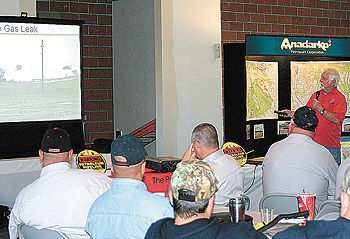| Robert Bruton speaks about pipeline safety. |
There are more than 2.4 million miles of hazardous liquid and natural gas pipelines running throughout the United States underground. These pipelines include large diameter lines and small diameter lines. Some carry petroleum products, some carry water, and still others carry electricity. No matter what the pipeline is carrying, a disaster could happen if the pipeline is damaged in some way.
Robert Bruton of the Pipeline Group, opened the program by saying, “This educational presentation is sponsored by Anadarko Petroleum Corporation, Questar, and XTO Energy Inc. They believe in safety and in greater public awareness of the pipelines which are running underground.”
Bruton stated the first oil well was drilled in 1865 in Pennsylvania. This resulted in the first pipeline in the US and it was five miles long. Today pipelines have been installed throughout the US. In Utah, there are 42,874 miles of pipelines carrying petroleum products, as well as chemical. These pipelines run from the site of production, to the processing plants, and on to the consumers.
As for the petroleum products, there are two types, liquid and gaseous. Liquid fuels vapors are heavier than air and will sink to the lowest point on the surfaces around the discharge. Gaseous vapors are lighter than air and will rise above the discharge site.
Either type of an accidental discharge can be very dangerous, and the purpose of this presentation is to educate contractors, excavators, county crews and city crews of the dangers of digging before the underground lines are located.
“Call before you dig, it’s the law in Utah,” said Bruton. “Anyone who is doing any type of construction or excavation work must call at least two days before the work is to begin. This allows time for the pipeline owners in the area of the excavation to visit the site and mark the location of their pipelines. Think, practice and live safety.”
A person should visually check the entire area before any excavation is begun. The pipeline companies will post signs, and many of the companies have different kinds of signs. Each of the signs, no matter what kind it is, will have the company name and contact information on them. To be safe, call the company and get educated about where the pipelines are.
The notification center in Utah is the Blue Stakes program. All underground utilities in Utah belong to the Blue Stakes program. Everyone who plans to do any excavation must call Blue Stakes before beginning to dig. That includes all professional contractors and even do-it-yourself projects.
A copy of Utah State law can be obtained as www.bluestakes.org. The telephone number for Blue Stakes is 1-800-662-4111, and must be made two days in advance of the digging project, and no more than seven days. This application will require some personal information plus all the locational information about the project as possible.
A verification number for the project will be given. Keep this number on file. Members of the utility that belong to Blue Stakes will come to the site and mark any facilities which they have in your area.
If things should go wrong and damage is done to a pipeline, you need to be able to recognize and deal with the problem. Report any damage done to a pipeline, even something as minor as a scratch, to the owner. A scratch could cause the pipeline to corrode or rupture sometime in the future, and the owner of the pipeline will want to do any repair it deems necessary before the line is reburied.
Be alert for sounds, smells or otherwise noticed clues to pipeline damage. If you detect any damage, call 911 immediately. They will notify the emergency responders and will take steps to evacuate the area if necessary. Call the utility involved and keep people out of the area. Just because the gas may not be burning or may have exploded immediately, doesn’t mean that it will not. Many times explosions happen some time after the rupture of the pipe.
Not only are pipelines dangerous, but electricity lines, water lines, sewer line, drain lines and communication and cable TV lines are underground. Disruption of these services can be very costly also, not only in terms of dollars but the disruption of emergency services. If telephone lines are out, no one in the area will be able to place a phone call to 911.
Wrongful death law suits have been filed against contractors who disrupt communications, and someone has died because emergency services could not be contacted. The bottom line is ‘Call before you dig. Everyone should know the products that are transported by pipelines in the area, enter any questionable area from upwind, evacuate everyone to a safe distance, identify the utility and notify them, extinguish any secondary fires, do not interfere with the operation of the pipeline and do not shut off any valves, work in harmony with the incident commander, and keep any escaping liquids from entering manholes or drains.
Blue Stakes was organized more than 30 years ago with the three major utilities as members. Now, more than 400 entities are members. Everyone is reminded to dig safely and call before you dig. Blue Stakes has numerous materials available for contractors and private citizens to explain the Dig Safely campaign. Call 1-800-662-4111 or visit www.bluestakes.org.

